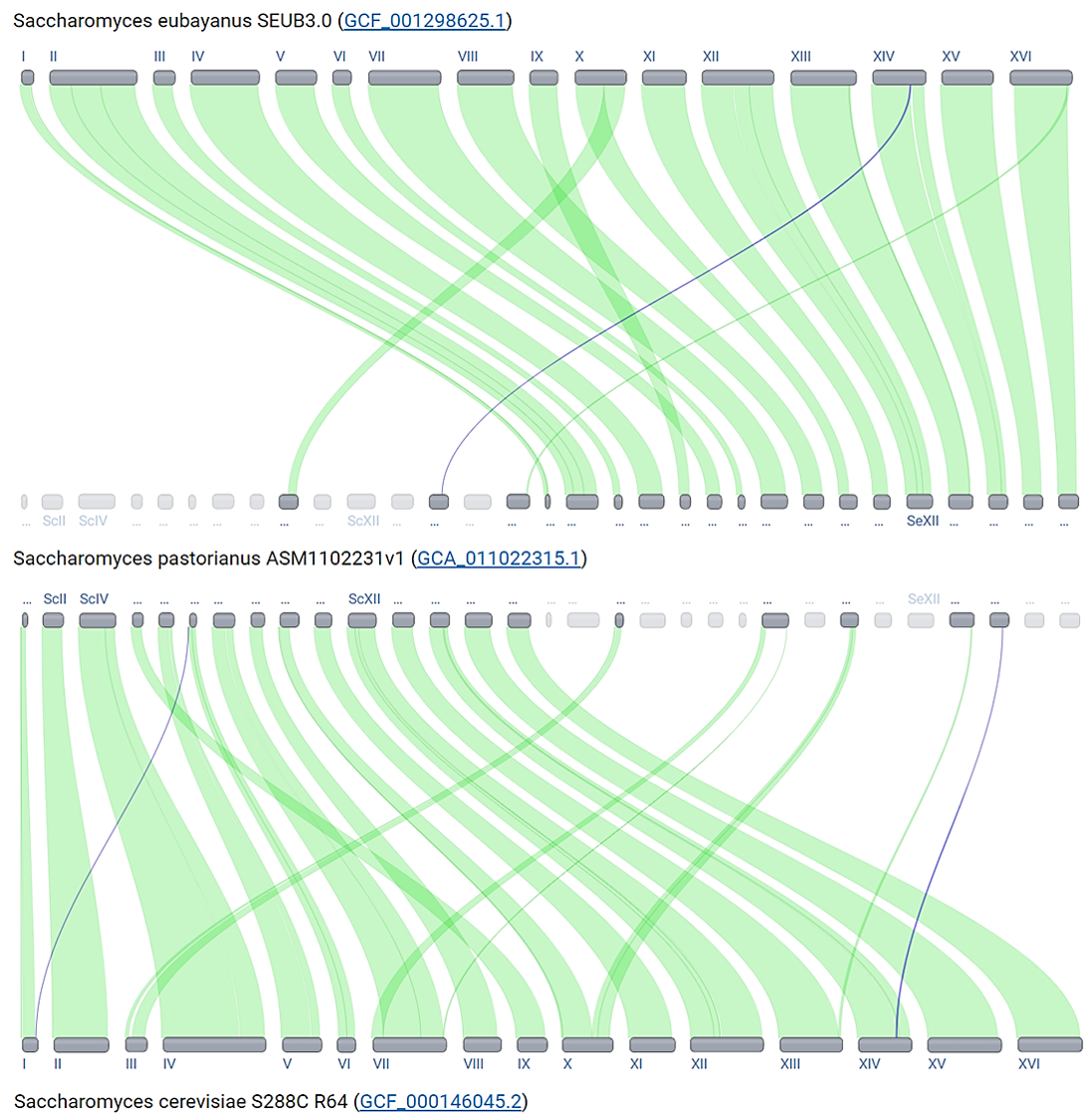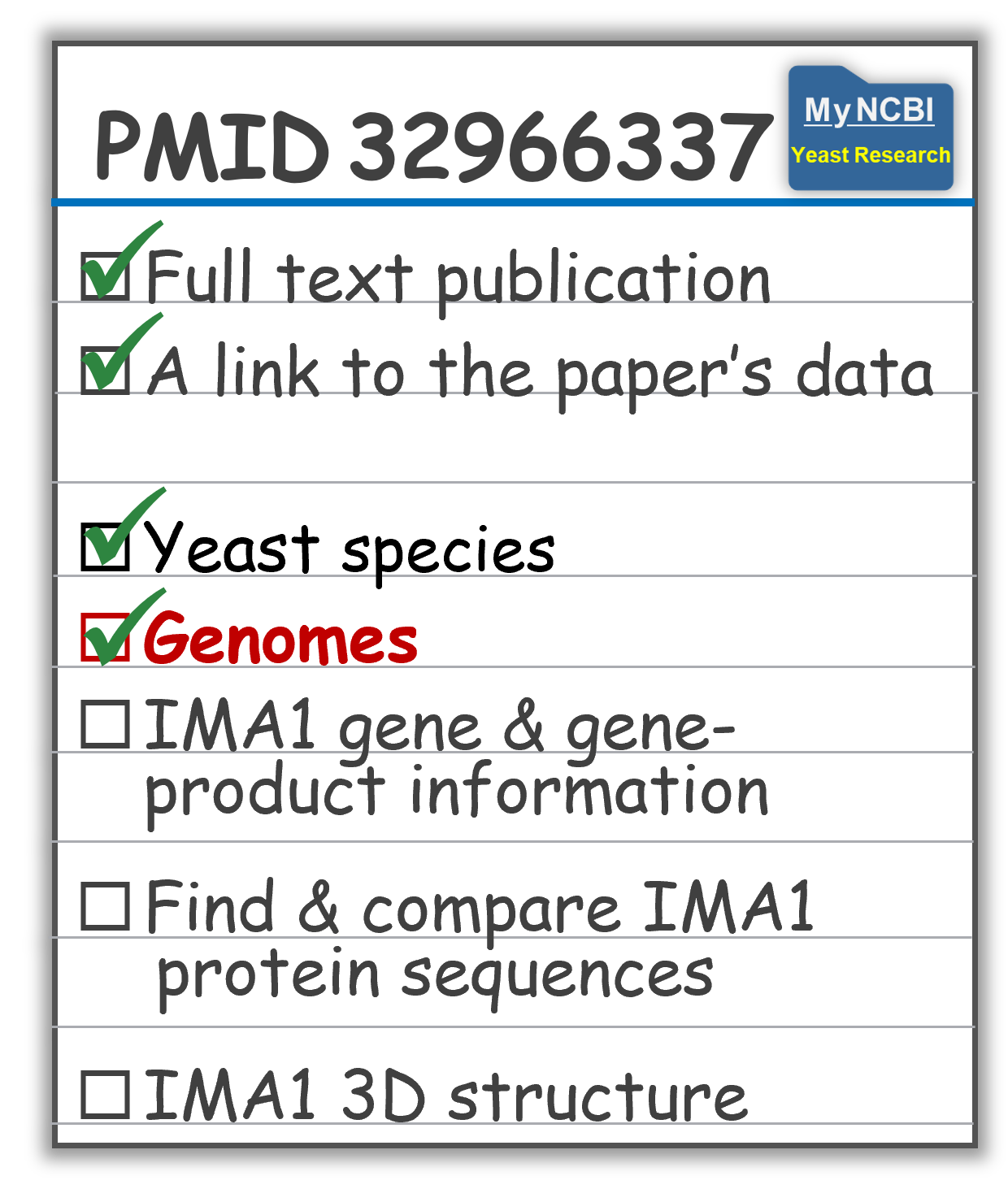Step 3: Finding available genome data for your organism
Background
Modern biology often relies on information encoded in an organism's genome. Comparative genomics, the study of two or more genomes to understand differences or similarities between organisms is an imporant and growing area of research.
In the paper that Dr. Smythe gave you, they are looking at two different yeast species and have indicated that these have different phenotypes.
For the next step of your research, we'll find and save a link to the genomes for each of those two Saccharomyces species. We'll show you how to download genomic data and introduce you to a new tool you might want to explore later in your research project.
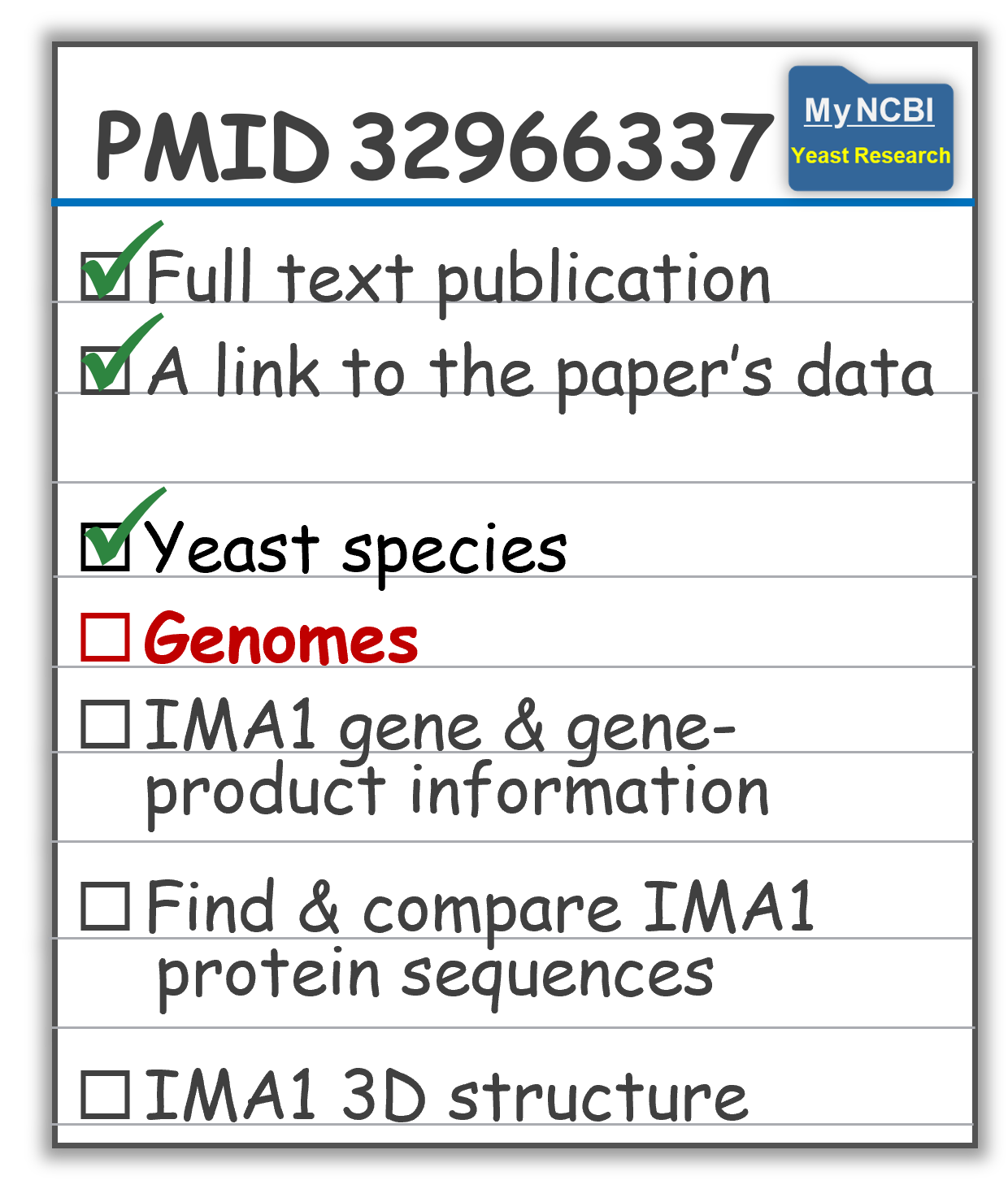
In the paper that Dr. Smythe gave you, they are looking at two different yeast species and have indicated that these have different phenotypes.
 Click here to review these.
Click here to review these.
| Phenotype | Saccharomyces cerevisiae |
Saccharomyces pastorianus |
| Fermentation mode | Top fermenter (produces ales) |
Bottom fermenter (produces lagers) |
| Optimal fermentation temperature (range-ish) | warm (60-72°F) |
cool (40-55°F) |
| Import mechanism for maltose-related sugars | facilitated active transport | proton symport |
| Metabolism of maltose-related carbohydrates | Does some fine, cannot metabolise melibiose |
Metabolizes all maltose-related carbohydrates well. |
For the next step of your research, we'll find and save a link to the genomes for each of those two Saccharomyces species. We'll show you how to download genomic data and introduce you to a new tool you might want to explore later in your research project.

Where can you find genome information?
NCBI's Genome database is great place where you can find information on the genomes of particular organisms. Based on what information we have been provided and developed, you can see data on the whole genomic assembly, individual chromosomes, and even the annotations (labeling of regions, such as genes). We also provide access to sequence data at the genome, transcript and protein level for everything encoded in the genome.
NOTE: While this is still a great resource, the data are being transitioned to a newer set of pages with an improved look-and-feel. So we'll show you the current NCBI Genome database and also show you the new pages which are and will continue to be iteratively updated.
NCBI's Reference Sequence (RefSeq) group is made up of experts who collate and sequence and metadata provided by research labs all over the world and perform their own research and add additional supporting information to them. The subsequent standardized and improved sequences with annotations are labeled "Reference". To learn more about RefSeq's curation and annotation process see these documents: Eukaryotic Genome Annotation or Prokaryotic Genome Annotation.
These RefSeq experts in genomes of taxonomic groups also work with related community consortia and specialty groups to identify high quality and important genomic assemblies to suppliement the work the RefSeq team has done. Often they are able to designate a particular genomic assembly or a couple of assemblies as "Representative" ones for certain organisms to assist researchers in identifying one of many to focus on, if necessary.
These RefSeq experts in genomes of taxonomic groups also work with related community consortia and specialty groups to identify high quality and important genomic assemblies to suppliement the work the RefSeq team has done. Often they are able to designate a particular genomic assembly or a couple of assemblies as "Representative" ones for certain organisms to assist researchers in identifying one of many to focus on, if necessary.
From your Taxonomy retrieved results you can quickly get to any genome records that exist for your organisms.
1. From the Taxonomy retrieved result, check the box next to each of your yeast species.
2. On the right-hand side of the page in the "Find related data" section, change the pull-down menu to Genome and then click "Find items".
3. That's all you need to do!
2. On the right-hand side of the page in the "Find related data" section, change the pull-down menu to Genome and then click "Find items".
3. That's all you need to do!
 Alternatively, you can just search Genomes directly with the names of the two organisms mentioned in the paper as you did with Taxonomy.
Alternatively, you can just search Genomes directly with the names of the two organisms mentioned in the paper as you did with Taxonomy.
1. Go to the Genome homepage: https://www.ncbi.nlm.nih.gov/genome or click on the pull-down menu at the top of most NCBI pages and select "Genome".
2. Search with:
saccharomyces cerevisiae OR saccharomyces pastorianus
3. Again, due to the "OR" boolean operator, you will retrieve both organisms' genome records!
2. Search with:
saccharomyces cerevisiae OR saccharomyces pastorianus
3. Again, due to the "OR" boolean operator, you will retrieve both organisms' genome records!
Save the Genome pages to the Yeast research folder!
1. Check both boxes and click "Send to" to add to the existing Yeast research folder.
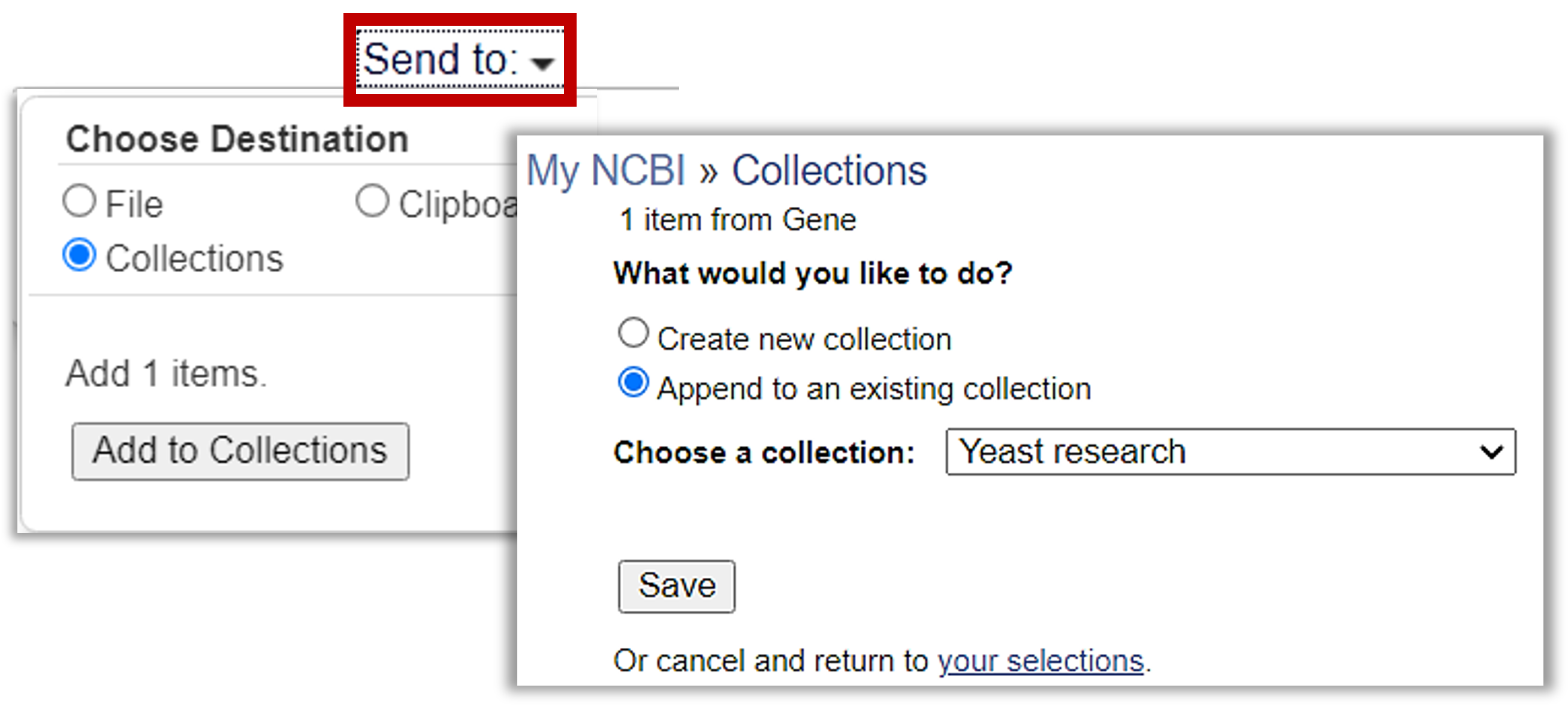  |
Let's take a look at those Genome pages to see what information is available for your organism!
1. Click on the names of each of the two Saccharomyces species to look at the records.
2. Note the box at the top of each record. This has a bunch of hyperlinks to download data directly to your computer for the Reference or Representative genome. (Note, this is one of the reasons for the webpage redesign.)
BUT very soon you will be redirected to the "new" page and so you should consider downloading the data only from the new page. |
Okay, it's time to see the new Genome pages.....let's see what we can learn and what types of data you can download from there!
1. It may be as early as next week when you will automatically be re-directed to these new pages. But for now, click on the links at the top of these pages to see the new NCBI Datasets Taxonomy pages for each organism. Or click here:
2. These are summary "Taxonomy" pages and have a summary Genome section. Scroll down and see how they describe each's genome.
To learn more about the specific Genomes, click on the hyperlinked "name" of each assembly and see what we know about them!
1. These are the new combined Genome/Assembly pages with a lot of information about the genome assembly including description of the sample, statistics, annotation information and some nice pictures of chromosomes along with a data corresponding.
Look at the picture and/or table of chromosomes and compare how many there are for each of these Saccharomyces species.What do you notice?
2. From the old Genome page, there were descriptions for each yeast species.
2. From the old Genome page, there were descriptions for each yeast species.
 Click and take a look.
Click and take a look.
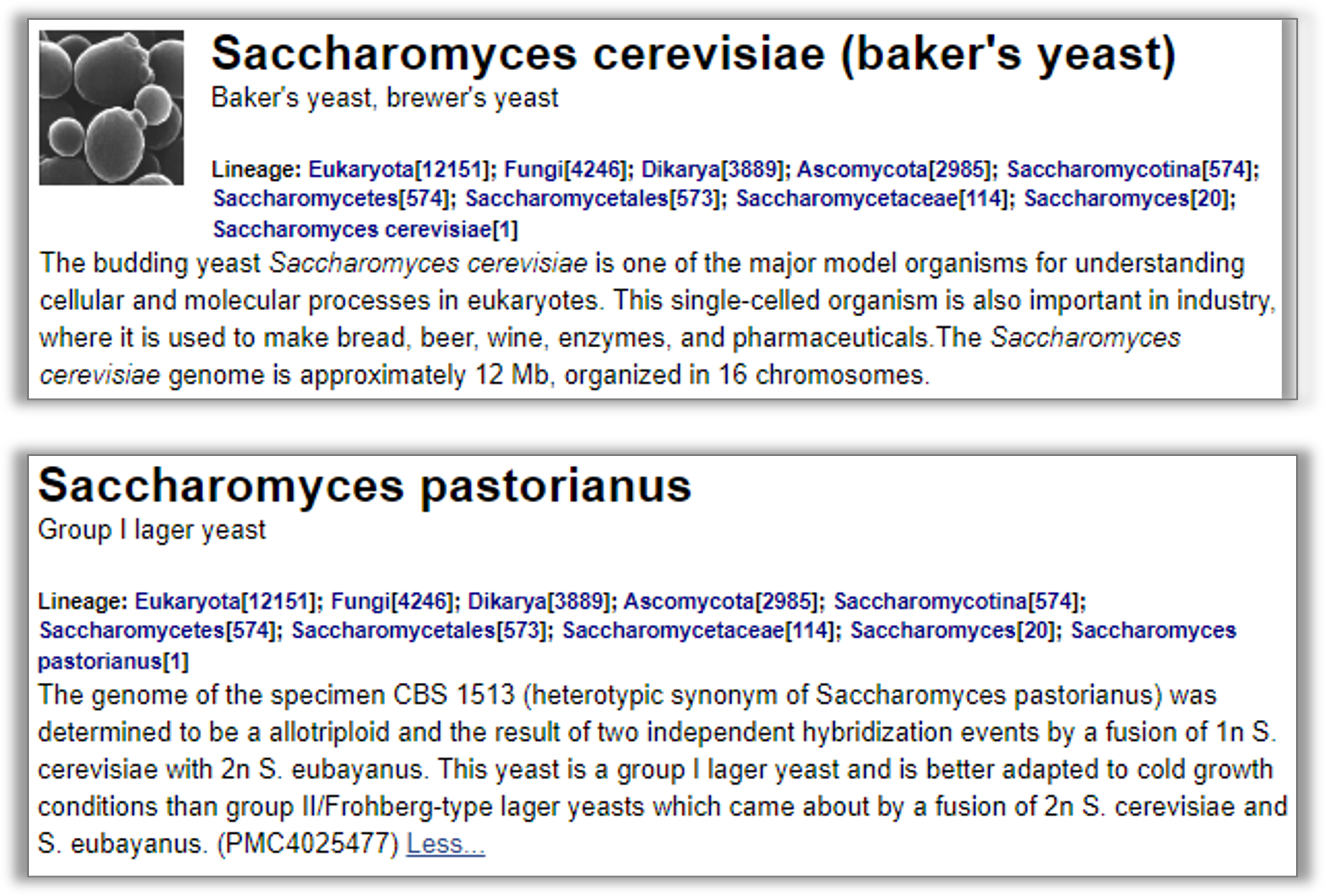
3. Looking back at those chromosomes and their names...
|
There's a new advanced tool for that. There have long been rumors about the origin of that bottom-fermenting yeast, including that new life-form was transported on the silk-road from asia or teleported down from outer-space. Recently, using genomics it has been suggested that this arose as a product of fusion of three Saccharomyces cells: 1n S. cerevisiae & 2n S. eubayanus NCBI has created a new tool to compare two organism's genomic sequences. Let’s look at the possible origins of Saccharomyces pastorianus' chromosomes using the new Comparative Genome Viewer (CGV) with the assemblies from each Saccharomyces species.
|
What should we do next to prepare for our research discussion with Dr. Smythe?
Last Reviewed: June 28, 2023


